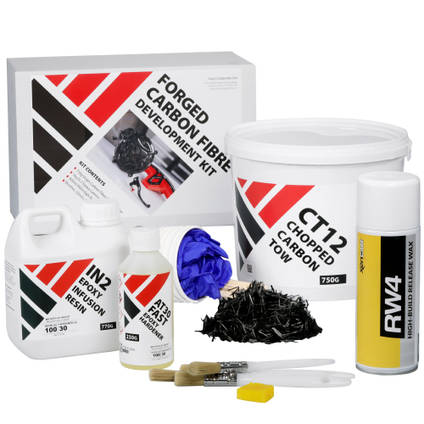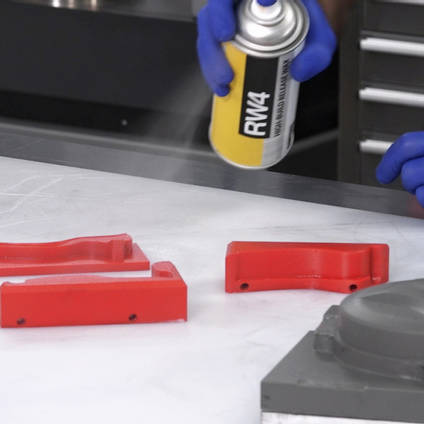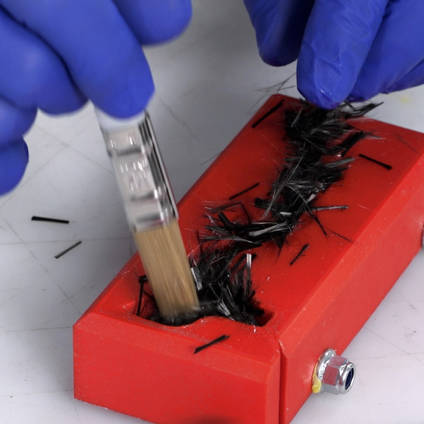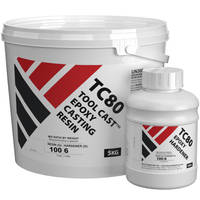Need any help or advice?+44 (0)1782 454499
Downloads (7)
This is a chemical product. Before storage or use you must download and read the accompanying safety and technical datasheets.
| Chopped Tow Safety DataSheet (SDS) | ||
| IN2 Dutch Safety DataSheet | ||
| IN2 Safety DataSheet (SDS) | ||
| RW4 Safety DataSheet (SDS) | ||
| RW4 Dutch Safety DataSheet | ||
| Filleting Wax Safety DataSheet (SDS) | ||
| Forged Carbon Example Compression Moulds CAD Files |
Specification
General Properties
| Gross Weight | 2.65 | kg |
|---|---|---|
| Brand | Easy Composites |
Shipping Information
Restrictions
This product is classed as dangerous goods for transport.
It can be shipped to all mainland EU countries, Ireland, Balearic Islands, Corsica, Sicily and Sardinia.
Unfortunately, for the time being we are unable to ship dangerous goods to Cyprus, Malta, the Canary Islands, Ceuta, Melilla, Jan Mayan and Svalbard.
For a full information regarding the shipment of dangerous goods, see our delivery information page.
Package Size
There are no package size restrictions or surcharges for this product.
Delivery Cost
To find the delivery cost of this item to your address, add it to your basket and then use the instant shipping calculator on the basket page.
Forged Carbon Fibre Development Kit
- Easy Composites
- SK-FCF
Hazardous
- 5/5 Average rating
This kit includes all of the materials required to undertake compression moulding of high performance forged carbon fibre components. All that is required is a two-part compression mould made from cast resin, 3D printed or machined metal.
Contains 750g premium quality CT-12 virgin chopped tow carbon fibre, 50g of long strand carbon tow, high-performance IN2 epoxy infusion resin, RW4 high-build spray wax and ancillaries.
AVAILABILITY:More than 20 availablefor immediate shipping
We won’t be beaten on price!
If you believe you’re buying an equivalent product cheaper elsewhere, contact us to discuss your requirements.
Forged carbon components provide excellent mechanical performance that can rival or better that of metals and allows fully moulded shapes to be produced that would be almost impossible using traditional single-sided composite moulding methods. This development kit has been put together to allow engineers and keen hobbyists to experiment and prototype with this highly effective process.
The kit includes 750g of premium quality CT-12 virgin chopped tow carbon fibre, our high-performance IN2 epoxy infusion resin, RW4 high-build spray wax and ancillaries, all of which work together and will create forged carbon fibre parts with outstanding mechanical properties.
The kit is designed to work in tandem with our forged carbon fibre video tutorial to provide an accessible, reliable and comprehensive introduction to the process of compression moulding solid carbon fibre components.
New for 2024, the kit now also includes a 50g pack of long-strand carbon fibre tow to allow for experimentation with strength optimisation using unidirectional reinforcement within the forged carbon component.
Typical Uses
This Development kit is ideally suited to anyone looking to explore this highly effective manufacturing process and produce functional forged carbon fibre components. Common applications include light-weighting of assemblies by replacing metal components, development of new lightweight structural elements, production of aftermarket and upgraded automotive components and many more uses where conventional composites may not be appropriate. A notable benefit of this process is that It allows the production of high-strength components using only a conventional FDM 3D printer opening up a range of possibilities in this sector.
Use this kit to:
- Produce solid forged carbon fibre with excellent mechanical performance.
- Rapidly prototype mechanical components without specialist machinery.
- Reduce weight by upgrading from metal components
Quantity
The kit includes 750g of CT12 chopped carbon fibre tow, 50g of long strand carbon fibre tow (cut to approximately 250mm length) and 1kg of IN2 epoxy infusion resin, which provides enough material to produce approximately 1kg (or 0.7 litres) of solid carbon components due to the resin which is squeezed from the mould.
The Forged Carbon Fibre Process
Overview
Suitable Moulds
In order to use this kit to produce forged carbon fibre parts, you will require a set of moulds designed with compression moulding in mind. These compression moulds can be made by 3D printing, resin casting or CNC machining, as described in the tutorial. See also our tutorial on resin casting a two-part compression mould.
Mould Preparation
Before laminating, all mould sections should be prepared using multiple applications of RW4 spray release wax (included in kit). Any holes or bolt threads should be sealed or smoothed using filleting wax (also included).
Fibre and Resin Loading
The chopped carbon fibre tow and low viscosity epoxy should be accurately weighed and loaded into the mould. This will appear to mean overloading the mould cavity, which is the reason why the mould needs to be designed with some 'compression space'.
Compression
Once the moulds have been loaded with fibre and resin the two mould halves can then be compressed together, This clamping can be done with either a bench vice, G-clamps, or a press. The compression needs to be done gradually over a period of a several minutes to allow time for the excess resin to escape.
Curing and Finishing
After curing at room temperature for around 24hrs, the part can be demoulded and any flashing or nibs removed using abrasive paper. Parts produced from a 3D printed mould can have their layer lines removed using abrasive paper if required.
Where a high-gloss finish is preferred, components can be finished using a spray applied clear-coat or brush applied XCR coating resin (not included).
Full details of the process can be found on our compression moulding forged carbon fibre project page.
Additional information about mould design and use of the long-strand carbon fibre tow for strength optimisation can be found in the follow-up forged carbon mould design and strength optimisation video tutorial.
What Results Can I Expect?
Done correctly, this forged carbon fibre moulding process is remarkable reliable, consistent and capable of producing accurate components with excellent mechanical properties and very low void content.
The success of the process will largely depend on the design and accuracy of the compression moulds, accuracy of material measurement and - to some extent - appropriate distribution of the reinforcement, all of which should be within the scope of any engineer or keen hobbyist. The surface finish is mostly influenced by the mould tools; machined, resin cast or resin printed tools will generally offer a finer finish than FDM printed ones where the layer-lines will be transferred into the part. For cosmetic finish parts, some minor fettling or filling can be required.
Kit Contents
- 750g CT12 chopped tow carbon fibre
- 50g of long strand 6k carbon fibre tow cut into approximately 250mm lengths.
- 1kg IN2 infusion epoxy (inc. AT30 fast hardener)
- 400ml RW4 high-build spray release wax
- 10g filleting wax
- 5 pairs nitrile gloves, 5 mixing pots, 5 mixing sticks
- 5 laminating brushes (12mm)
Forged carbon components provide excellent mechanical performance that can rival or better that of metals and allows fully moulded shapes to be produced that would be almost impossible using traditional single-sided composite moulding methods. This development kit has been put together to allow engineers and keen hobbyists to experiment and prototype with this highly effective process.
The kit includes 750g of premium quality CT-12 virgin chopped tow carbon fibre, our high-performance IN2 epoxy infusion resin, RW4 high-build spray wax and ancillaries, all of which work together and will create forged carbon fibre parts with outstanding mechanical properties.
The kit is designed to work in tandem with our forged carbon fibre video tutorial to provide an accessible, reliable and comprehensive introduction to the process of compression moulding solid carbon fibre components.
New for 2024, the kit now also includes a 50g pack of long-strand carbon fibre tow to allow for experimentation with strength optimisation using unidirectional reinforcement within the forged carbon component.
Typical Uses
This Development kit is ideally suited to anyone looking to explore this highly effective manufacturing process and produce functional forged carbon fibre components. Common applications include light-weighting of assemblies by replacing metal components, development of new lightweight structural elements, production of aftermarket and upgraded automotive components and many more uses where conventional composites may not be appropriate. A notable benefit of this process is that It allows the production of high-strength components using only a conventional FDM 3D printer opening up a range of possibilities in this sector.
Use this kit to:
- Produce solid forged carbon fibre with excellent mechanical performance.
- Rapidly prototype mechanical components without specialist machinery.
- Reduce weight by upgrading from metal components
Quantity
The kit includes 750g of CT12 chopped carbon fibre tow, 50g of long strand carbon fibre tow (cut to approximately 250mm length) and 1kg of IN2 epoxy infusion resin, which provides enough material to produce approximately 1kg (or 0.7 litres) of solid carbon components due to the resin which is squeezed from the mould.
The Forged Carbon Fibre Process
Overview
Suitable Moulds
In order to use this kit to produce forged carbon fibre parts, you will require a set of moulds designed with compression moulding in mind. These compression moulds can be made by 3D printing, resin casting or CNC machining, as described in the tutorial. See also our tutorial on resin casting a two-part compression mould.
Mould Preparation
Before laminating, all mould sections should be prepared using multiple applications of RW4 spray release wax (included in kit). Any holes or bolt threads should be sealed or smoothed using filleting wax (also included).
Fibre and Resin Loading
The chopped carbon fibre tow and low viscosity epoxy should be accurately weighed and loaded into the mould. This will appear to mean overloading the mould cavity, which is the reason why the mould needs to be designed with some 'compression space'.
Compression
Once the moulds have been loaded with fibre and resin the two mould halves can then be compressed together, This clamping can be done with either a bench vice, G-clamps, or a press. The compression needs to be done gradually over a period of a several minutes to allow time for the excess resin to escape.
Curing and Finishing
After curing at room temperature for around 24hrs, the part can be demoulded and any flashing or nibs removed using abrasive paper. Parts produced from a 3D printed mould can have their layer lines removed using abrasive paper if required.
Where a high-gloss finish is preferred, components can be finished using a spray applied clear-coat or brush applied XCR coating resin (not included).
Full details of the process can be found on our compression moulding forged carbon fibre project page.
Additional information about mould design and use of the long-strand carbon fibre tow for strength optimisation can be found in the follow-up forged carbon mould design and strength optimisation video tutorial.
What Results Can I Expect?
Done correctly, this forged carbon fibre moulding process is remarkable reliable, consistent and capable of producing accurate components with excellent mechanical properties and very low void content.
The success of the process will largely depend on the design and accuracy of the compression moulds, accuracy of material measurement and - to some extent - appropriate distribution of the reinforcement, all of which should be within the scope of any engineer or keen hobbyist. The surface finish is mostly influenced by the mould tools; machined, resin cast or resin printed tools will generally offer a finer finish than FDM printed ones where the layer-lines will be transferred into the part. For cosmetic finish parts, some minor fettling or filling can be required.
Kit Contents
- 750g CT12 chopped tow carbon fibre
- 50g of long strand 6k carbon fibre tow cut into approximately 250mm lengths.
- 1kg IN2 infusion epoxy (inc. AT30 fast hardener)
- 400ml RW4 high-build spray release wax
- 10g filleting wax
- 5 pairs nitrile gloves, 5 mixing pots, 5 mixing sticks
- 5 laminating brushes (12mm)
Downloads (7)
This is a chemical product. Before storage or use you must download and read the accompanying safety and technical datasheets.
| Chopped Tow Safety DataSheet (SDS) | ||
| IN2 Dutch Safety DataSheet | ||
| IN2 Safety DataSheet (SDS) | ||
| RW4 Safety DataSheet (SDS) | ||
| RW4 Dutch Safety DataSheet | ||
| Filleting Wax Safety DataSheet (SDS) | ||
| Forged Carbon Example Compression Moulds CAD Files |
Specification
General Properties
| Gross Weight | 2.65 | kg |
|---|---|---|
| Brand | Easy Composites |
There is no clearance. Once fully clamped, the mould halves are designed to be in full contact. As you are clamping the mould, there is still a gap as you wind on the pressure which is where the resin and air escapes from. Once fully clamped together, there will be no excess to squeeze out and hence no need to have any clearance.
Adding Kevlar into the mix could certainly help, much like with the hybrid carbon Kevlar fabrics available for laminating processes.
We have meaured and investigated the properties of forged carbon parts in this video: Investigating the Mechanical Performance of Forged Carbon Fibre Components.
It's quite difficult to give specific maximum and minimum dimensions for overall size, and wall thickness of parts because the shape and geometry of a component has a significant bearing on these other parameters, as does the mould strength and clamping compression force. To give some approximate indications we'd suggest that thickness should be at least 1mm and not more than 10mm. Overall component size really does come down to practicalities of the moulds and clamping arrangements but again, as a ballpark, maybe 500mm x 500mm. In terms of what scale of detail can or should be included, there's not really any constraints on this other than the fact that you'll probably need to do some sanding and fettling of the finished components and so any detail smaller than, say, 0.5mm should probably be avoided as it's likely to be rubbed out or softened by the finishing process anyway.
Literally just the filleting wax is used. The light bond to the surface and the small area being filled with wax means you do not get any bleed through past the wax.
The IN2 resin used in this kit, has a HDT of around 80C after an oven post cure. It depends where on the engine the part is located and ideally it would be best to measure the temperature of the existing part when the engine is very hot to ensure it would be suitable.
No, the resin is quite low viscosity which helps avoid air entrapment and also the compression itself helps squeeze out any remaining air and excess resin.
Hi, that's a very good question. We did originally develop the kit using the AT30 SLOW hardener for this same reason but we fairly soon realised that it doesn't take very long to get the resin out of the pot and into the mould, generally you're working on relatively small parts and most of the time is in dabbing, consolidating, prodding, closing, clamping. For all of these operations the resin is already out of the pot and so its cure rate is much slow. The 17 mins 'pot-life' really does refer to the time the resin can sit in the pot, once it's on the mould and wetted into reinforcement, you've got more working time and in our experience, we never had a problem with working time on any of these components. If you're working on particularly large or complex parts and feel you need more working time than the AT30 FAST provides, you could just purchase some AT30 SLOW on its own, which could be used instead or mixed with the FAST to create a 'medium', giving you plenty more working time.
The epoxy used in the kit is our IN2 Infusion Epoxy which is designed to have a maximum service temperature of 75°C with an oven post cure.
The process of skinning with forged carbon is better suited to the resins in the skinning kit. So this kit would have a lot of materials you won't use. You would be best buying the XCR resin and XCR basecoat separately with the tow to get the materials you need.
ASK YOUR OWN QUESTION
Customer Product Reviews for Forged Carbon Fibre Development Kit
Love the product, superior to other brands as well!!
Just awesome… nothing more needs to be said to be honest. I was pleasently surprised by how easy it was to get a nice product in the end. This is one of the very few video-advertised products where expectation converts to reality 100%, especially on the first try. I honestly had more work 3D-printing the mold than with the rest of the process. I‘m really looking forward to using the kit in many little projects.
Bought the forged carbon and prepreg kit to get to know how carbon fiber parts are made. Well I've made like 3 parts for my motorcycle out of the forged carbon fiber, now looking to replace the TC80 with resin printed molds as i'm already familiar with 3d modelling and I can be lazier lmao. Thanks guys for bringing this knowledge with the kits to the general population :)
I've used the kit a number of times now for some smaller and quite complicated parts. It's extraordinarily well suited to these types of jobs - very pleased with the results. However, with the nature of smaller/thinner parts, it would be really helpful if it was possible to purchase quantities of continuous tow, separate to the kit, to build in the additional unidirectional strength where needed.
Bought the kit, followed the instructions and got a functional RC car part first try. There were a lot of thin, deep sections in my molds and for those I'd recommend 1. using more mold release than you think you need and 2. I'll probably pick up the slow hardener too, because loading those areas can take more time than the what fast hardener allows. Overall still a great kit, definitely recommended.
Just used the kit yesterday. Awe-some! Really. It's so comprehensive and a perfect use, especially for educational practical assignments.
Saw this video, went to your webshop, ordered everything, and made a quadcopter frame out of forged CF. It turned out great. The most challenging part was the mold design. I recorded the entire process, it's on my channel.
Surprised myself with a Forged Carbon kit for Christmas, gave it go right away and I'm blown away how easy it was to follow the steps in the video. Super happy with the first part, really in love with its looks. My next order of tools, resins, cleaners, etc. on your website has already been placed. Keep these videos coming!
First time making anything and using easy composite YouTube video and their kit I got great results!
I bought your development kit and have been printing moulds and making parts successfully. Absolutely love this process and your development kit was the perfect package.
I bought the forged carbon starter kit because I saw your last video. Got my first part done yesterday. It turned out amazing. Thanks for those informative videos. Please keep it up👏🏼
Very interesting results, I did try your forged carbon fibre method the other day and turned out great!
I LOVE IT! Great video! I've purchased the forged starter kit and made my first part. I am still really impressed - awesome product! Those tests you ran are great for showing the potential of the process. Is it possible to get those sets of data? I would love to use this method for designing and manufacturing the steering wheel of my teams formula student car.
We are super impressed with the product and the ease of use as well as the result. Just finished our first sample piece and have already had 2 enquires for parts using your product !! Looking forward to future projects using your products!
SUBMIT YOUR OWN PRODUCT REVIEW
We publish all reviews for verified purchases. Submit your own review and help other customers with their choices.SUBMIT YOUR OWN PRODUCT REVIEW
We publish all reviews for verified purchases. Submit your own review and help other customers with their choices.Shipping Information
Restrictions
This product is classed as dangerous goods for transport.
It can be shipped to all mainland EU countries, Ireland, Balearic Islands, Corsica, Sicily and Sardinia.
Unfortunately, for the time being we are unable to ship dangerous goods to Cyprus, Malta, the Canary Islands, Ceuta, Melilla, Jan Mayan and Svalbard.
For a full information regarding the shipment of dangerous goods, see our delivery information page.
Package Size
There are no package size restrictions or surcharges for this product.
Delivery Cost
To find the delivery cost of this item to your address, add it to your basket and then use the instant shipping calculator on the basket page.
CUSTOMERS ALSO PURCHASED
CUSTOMERS ALSO PURCHASED
100% SECURE
PAYMENT METHODS
Easy Composites EU B.V., registered in the Netherlands 73601195. All content copyright (C) Easy Composites Ltd, 2025. All rights reserved.








